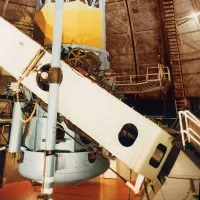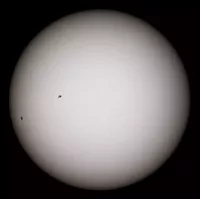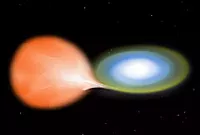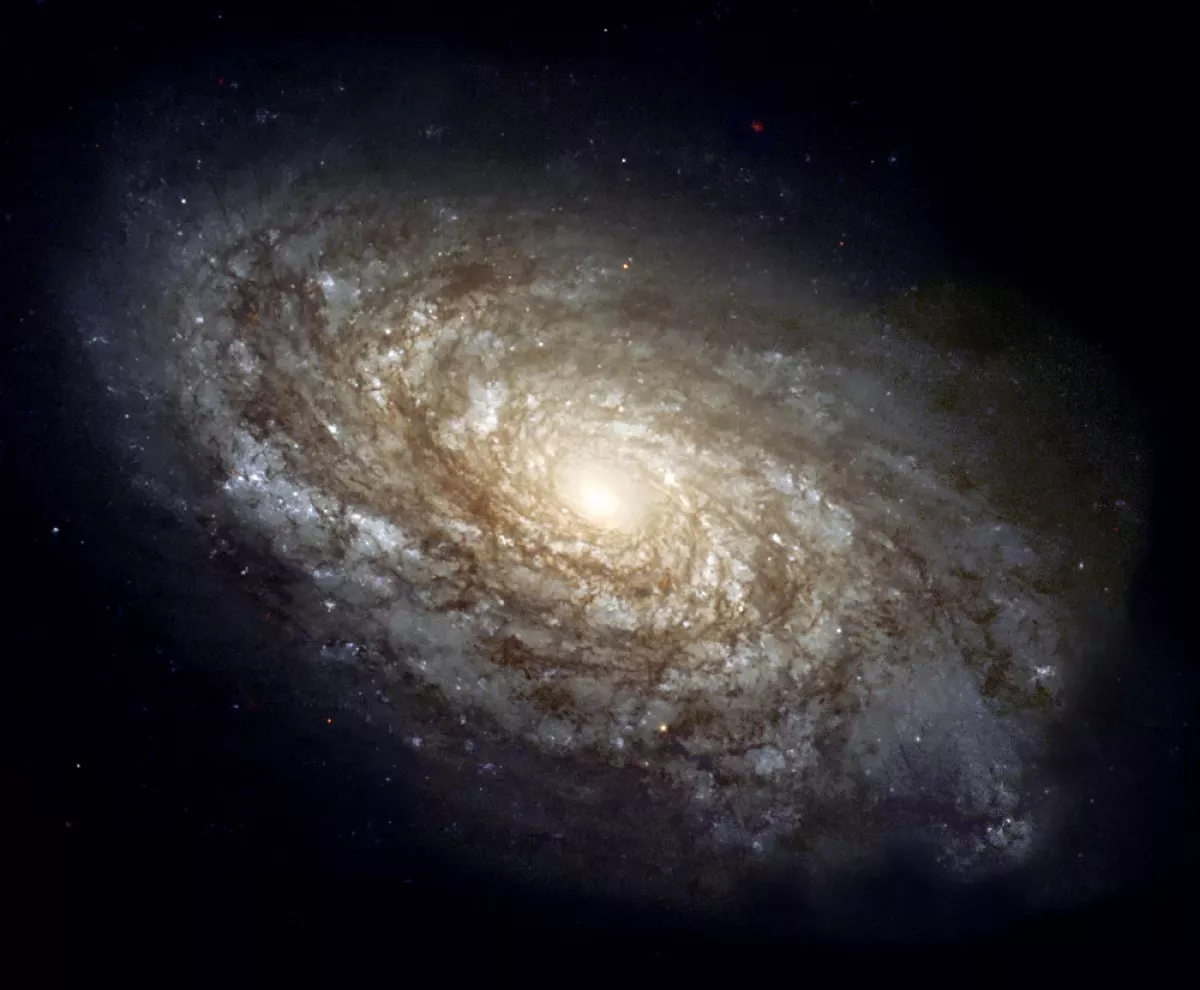Galaxies are vast systems of stars, gas, dust, and dark matter held together by gravity. The name comes from the Greek word for "milky," referring to our own Milky Way. Galaxies vary greatly in size, from dwarf galaxies with a few thousand stars to giant galaxies with trillions of stars. Most of a galaxy's mass is invisible dark matter. Supermassive black holes commonly reside at the centers of galaxies.
1912: Slipher's Observations of Spiral Nebulae
Vesto M. Slipher, in 1912, conducted spectrographic studies of spiral nebulae and found that they exhibited high Doppler shifts, indicating velocities exceeding those of stars. He also observed that most of these nebulae were moving away from us.
1917: Curtis's Nova Observations and the "Island Universes" Hypothesis
In 1917, Heber Doust Curtis observed novae within the "Great Andromeda Nebula" and, based on their faintness, estimated its distance to be 150,000 parsecs. This led him to support the "island universes" hypothesis, suggesting spiral nebulae were independent galaxies.
1920: Kapteyn's Model of the Milky Way
In 1920, Jacobus Kapteyn, using a refined approach based on star counts, proposed a model of the Milky Way as a small ellipsoid galaxy, about 15 kiloparsecs in diameter, with the Sun close to the center.
1920: The Great Debate: Shapley vs. Curtis
The Great Debate, a famous scientific debate between Harlow Shapley and Heber Curtis, took place in 1920. They debated the nature of the Milky Way, spiral nebulae, and the universe's dimensions. Curtis, arguing for Andromeda as an external galaxy, cited its dust lanes and Doppler shift as evidence.
1922: Öpik's Distance Determination of Andromeda
Ernst Öpik, in 1922, determined a distance for the Andromeda Nebula that supported the view it was a separate galaxy.
1926: Hubble's Classification of Galactic Morphology
Edwin Hubble, in 1926, developed a classification system for galactic morphology that remains in use today. This system categorizes galaxies based on their shape and structure.
1930: Trumpler's Discovery of Interstellar Dust
Robert Julius Trumpler, in 1930, quantified the effect of light absorption by interstellar dust, which had affected earlier models of the Milky Way. This discovery led to a more accurate understanding of the galaxy's size and shape.
1936: Early Attempts to Characterize Galaxy Diameters
As early as 1936, during Edwin Hubble's time, astronomers attempted to characterize galaxy diameters based on observed angles and estimated distances, resulting in angular diameters. However, these measurements faced challenges due to the need to correct for redshift-related space expansion and selection bias favoring luminous objects at greater distances.
1944: van de Hulst's Prediction of 21 cm Radiation
Hendrik van de Hulst predicted in 1944 that 21 cm microwave radiation from interstellar atomic hydrogen gas could be detected. This prediction was later confirmed in 1951.
1948: Introduction of Half-Light Radius
Gérard de Vaucouleurs introduced the concept of half-light radius (effective radius, Re) in 1948 as a measure of a galaxy's size based on its brightness flux. It represents the radius encompassing 50% of the galaxy's total brightness.
1951: Observation of 21 cm Radiation
In 1951, 21 cm microwave radiation from interstellar atomic hydrogen gas, as predicted by van de Hulst, was observed. This radiation allowed astronomers to map the motion of gas in the Milky Way, leading to the hypothesis of a rotating bar structure at the galaxy's center.
1963: Fish's Luminosity Concentration Law
In 1963, R. A. Fish established a luminosity concentration law connecting the brightness of elliptical galaxies to their respective effective radii, demonstrating the utility of the half-light radius concept.
1964: Discovery of cD Galaxies
In 1964, Thomas A. Matthews and colleagues described cD galaxies, a subtype of giant elliptical galaxies (D galaxies). These supergiant elliptical galaxies are characterized by a central elliptical nucleus and a vast, faint halo of stars extending to megaparsec scales. Their surface brightness profiles decrease more slowly with radius than smaller elliptical galaxies.
1968: Sérsic's Mass-Radius Relation
José Luis Sérsic defined a mass-radius relation in galaxies in 1968, further solidifying the significance of the half-light radius in understanding galaxy properties.
1976: Petrosian's Modified Method for Galaxy Size Estimation
Vahe Petrosian, in 1976, introduced a modified method for estimating galaxy size based on the azimuthally averaged profile of its brightness flux. This method has been employed by the Sloan Digital Sky Survey, using Petrosian magnitudes in the R-band to capture a galaxy's brightness flux while minimizing background noise.
2000: Bershady's Method for Measuring Half-Light Radius
In 2000, Bershady proposed a method for measuring the half-light radius that involved measuring twice the size where the brightness flux of a chosen radius, divided by the average flux, equals 0.2. This method aimed to capture the overall brightness flux of a galaxy.
2005: Critique and Correction of Petrosian's Method
In 2005, the Infrared Processing and Analysis Center critiqued an earlier version of Petrosian's method, pointing out a potential for magnitude errors compared to isophotal diameter measurements. The use of Petrosian magnitudes was also noted to miss light outside the Petrosian aperture, especially in elliptical galaxies. Graham et al. proposed a correction based on the assumption that galaxies follow Sérsic's law.
2006: Discovery of Galaxy IOK-1
In 2006, the galaxy IOK-1 was discovered with an unusually high redshift of 6.96, corresponding to just 750 million years after the Big Bang. This made it the most distant galaxy seen at the time.
June 2015: Evidence for Population III Stars
In June 2015, astronomers reported evidence for Population III stars in the Cosmos Redshift 7 galaxy, with a redshift value of 6.60. These stars are thought to be composed almost entirely of hydrogen and helium.
2016: Revised Estimate of Galaxies in the Observable Universe
A 2016 study led by Christopher Conselice estimated at least two trillion galaxies in the observable universe based on Hubble images. Later observations by the New Horizons probe revised this estimate to roughly 200 billion galaxies.
September 2022: Discovery of Galaxy JADES-GS-z13-0
In September 2022, the James Webb Space Telescope (JWST) discovered the galaxy JADES-GS-z13-0. It was confirmed to have a redshift value of 13.2, establishing it as the current earliest observed and most distant astronomical object known.
May 2023: Discovery of Faintest Galaxy JD1
In May 2023, a study identified the galaxy JD1 as the faintest one ever seen. Spectroscopic observations found a redshift value of 9.79, meaning JD1 was observed at 480 million years after the Big Bang.
2023: JADES-GS-z13-0: Galaxy or Dark Star?
In 2023, a study suggested that the object JADES-GS-z13-0, previously thought to be a galaxy, is actually a dark star. If confirmed, this would make UNCOVER-z13 the most distant galaxy instead.
Mentioned in this timeline

A telescope is an instrument used to observe distant objects...

The James Webb Space Telescope JWST is the largest space...

A star is a self-gravitating luminous plasma spheroid The Sun...

September is the ninth month of the year in the...

Novae are astronomical events where a bright seemingly new star...
Trending

7 months ago Lions seek edge rusher: Za'Darius Smith, veteran option alongside Aidan Hutchinson.
16 days ago Anthropic CEO to testify on Chinese AI cyberattack; Chatbots becoming criminals.

6 months ago Kash Patel, FBI Director, entangled in 2020 election conspiracy probe.

2 months ago Gwyneth Paltrow on Timothée Chalamet and Kylie Jenner's Relationship: 'Punk Rock'

Lisa Rinna is an American actress television personality and model known for her roles on soap operas like Days of...
8 months ago Barcelona and Real Madrid to Clash in Copa del Rey Final El Clasico.
Popular

Candace Owens is an American conservative political commentator and author...

Ilhan Omar is an American politician currently serving as the...

XXXTentacion born Jahseh Dwayne Ricardo Onfroy was a controversial yet...

Frederick Christ Trump Sr - was an American real estate...

Bill Gates an American businessman and philanthropist revolutionized personal computing...

Cristiano Ronaldo often nicknamed CR is a Portuguese professional footballer...
